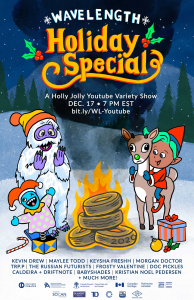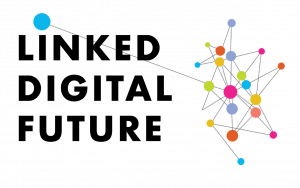Between October 2019 and March 2021, as part of the Linked Digital Future initiative (LDFI), the Digital Navigation Program offered one-on-one digital transformation coaching to arts organizations across Canada. Here is a second case study from one of the program’s participating organizations.
Wavelength is a unique Toronto based non-profit indie music organization. Started by musicians, they have been around for 21 years giving them an enviable history that is rare in the industry. They generate support and excitement for emerging musicians who are being overlooked by mainstream media. Wavelength, led by musician and author and Artistic/Executive Director Jonny Bunce, focuses on curation and diversity in programming. Historically, they represent a multitude of genres coming from Wavelength’s roots in indie DIY, punk rock, new music, and lately hip-hop.
I was delighted to have the opportunity to work with them.
Challenge
Initially, in their coaching sessions, they were looking to understand how to use their digital presence more effectively and find more about their audience. They also wanted to revamp their website, which was outdated and was not too functional, but had a huge amount of past events and artists. However, the pandemic upended all of those plans. So we quickly refocused.
COVID pivot

In the short term, we worked to identify immediate fixes on the website and SEO optimization. This gave them a platform to drive visitors to a “one-stop shop.” And then for the medium term, we realized that the website needed a complete redo, so they issued a Request for Proposals (RFP) for new website development/relaunch. This was completed and now they can start planning for the long term: integrating other digital platforms & abilities.
Wavelength also strategically considered a multi-phase step into dealing with the impacts of the pandemic and I was glad to help. They had already been using alternative venues for their live events, like bike workshops and woodworking studios, so moving online was in line with the DIY aesthetic.
Firstly, in the early days of March, Wavelength decided to amplify what was happening in the community, as artists big and small turned to performing online. They were all the “artists we knew and loved”, says Jonny. The website was critical in this phase.
Then, in April, they focused on education. They put on a series of workshops, 101 sessions, and webinars to build skills in their sector. Dan Mangan of https://sidedooraccess.com/ and Guillermo Subaste of https://www.streamtuneup.com/ provided artists with insight and education around streaming and technology. There was a lot of engagement as artists learned how to perform online.
While livestreaming concerts have been around for years, they have always been secondary to the live events. Now in the pandemic, Wavelength recognized that there were some new opportunities.
- Livestreams are great for engagement, as you can have a stronger tie with the artist.
- There is a lot of opportunity for visual creativity as the screen allows for integration with many different types of media.
- People won’t tolerate bad sound, so make sure that there is high-quality audio.
With this in mind, Wavelength started their own concerts in May. They realized that if most of the concerts were solo artists performing themselves from home, what was the role of a producer like Wavelength? It really brought them back to the DIY scene. The role was still to first make sure that artists were paid. And also, provide them with technical support.
Importantly, Wavelength could turn online shows into special events, by linking different artists together. They have always featured multiple artists, just like their live shows. As because during the pandemic, it was mostly solo artists that were able to perform, Wavelength events with multiple artists builds and fosters community. They do this by bringing together different communities of audiences into a bigger community. They also realized that any one performance can’t be too long.
Wavelength learned a lot about drop-off of audience numbers when they had ten artists in a 6-hour show, as that suffered drop-off by the end. They also experimented with timing of the concerts, giving them the opportunity to change when people wanted to see shows. It didn’t have to be at 8pm. In fact, they found the 5pm slot more effective. They completed a number of experiments and learned from each one.
They also considered ticketed shows with lots of internal debate. In the end, because of their mandate to support emerging artists, audiences don’t know the acts. So helping them build their fan base was key. As Jonny says, “I’d rather 100 people see a band for free rather than 10 people pay.”
Of course, it isn’t easy to ensure everyone is paid while revenue is $0. So, Wavelength generates sponsorship and grant revenue to keep it free. They initially also saved on production costs, but now as they move back into more traditional venues, they have added costs of camera crews. They are still able to subsidize this with support from the Canada Council for the Arts.
For their 2021 21st Winter Festival they had intended to try ticketing, but Harbourfront in Toronto came in with a contribution to support it free. This has given them the further motivation to try to keep this free for the rest of the year.
One thing that Wavelength has noticed is that while at the beginning of the pandemic there were a lot of live sessions, people are moving towards more pre-recorded so the artist can have control. But you still need to create a suspension of disbelief that can maintain the illusion that the act is live. Wavelength wants to preserve the feel like it is live. Like a mic could be dropped or anything could happen.
They have also increased their educational events, doubling them from last year.
Work with LDFI coach
For both the coach and Wavelength, the process was successful. As Jonny said, “It was a pleasure to work with Jai and he really ‘got’ our organization’s aesthetic and ethos. We are currently well positioned to undertake the next phase of digital transformation. He also was very engaged with our online music programming during the pandemic and encouraging of us to explore multiple platforms.”
From my perspective, I was very impressed with the strategic way that Wavelength approached the pivot from the pandemic. They knew their mandate and translated how that would work to the new pandemic realities. With their strong social following, and an enviable audience of Millenials, their understanding of the relationship between audiences and bringing artists together made many of their concerts very successful. They presented over 20 events last year.
Results
The importance of a clear vision for responding to a crisis is exactly what Wavelength proved. Their multi-phase, iterative approach led to understanding how they would be successful. They learned what needs to be improved and how to communicate that to potential collaborators. Plus, their phases used strategic thinking about the use of digital platforms for music presenting which gave them a strong base for all their shows. Their refocus on their web platform meant they are well set up for the future.
Lessons learned
- Revenue models are still shaky. The real issue of how still to pay for operations and artist costs plus venues have not been answered. We are still getting by with subsidies and grants. Sponsorship is very effective right now. It will shift though. But that is ok to have a biz model that works for the moment.
- Many concerts are going to be hybrid which gives the opportunity of a larger audience, especially for performers with a strong fan base.
- In-person is going to be like a premium experience. Only certain people are going to want/be able to go. Targeting by risk tolerance is acceptable segmentation. People are waiting until vaccinated.
- Ticket prices should reflect this premium experience. And flexibility will be the new norm in ticketing (cancelling, changing etc.).
- Live performance is still a big draw.
- Territories have long differentiated venues, but that is changing. When you can see an artist perform in Toronto online, is there a difference in seeing them online playing in Vancouver?
- Producing organizations will need additional reasons for audiences to watch. Adding value-added content: exclusives, premieres and also Behind the Scenes (BTS), podcasts, interviews, live discussion, will all be more important.
- Overall, the opportunity is to stop doing ineffective operations and focus on new ways and means of engaging audiences, which includes understanding them and using data. We can strengthen new inclusive and efficient foundations.






Trackbacks & Pingbacks
[…] Wavelength Music Arts Projects – Linked Digital Future Initiative Case Study […]
Leave a Reply
Want to join the discussion?Feel free to contribute!